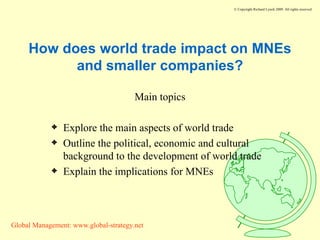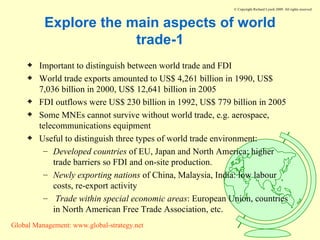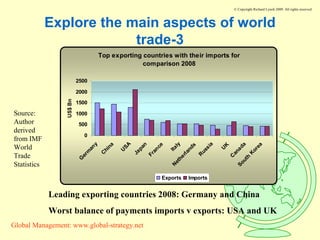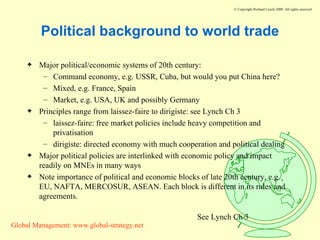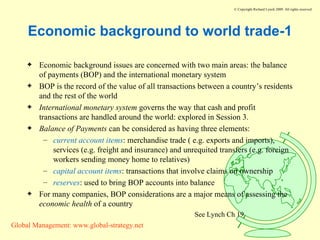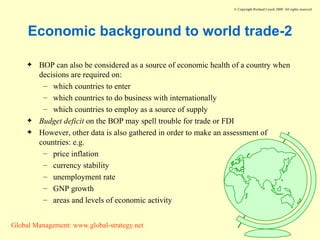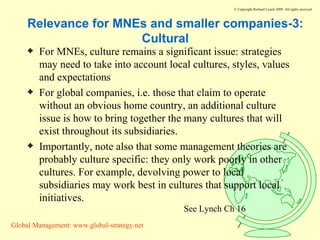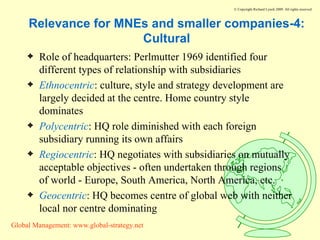Global Management 2
- 1. How does world trade impact on MNEs and smaller companies? Main topics Explore the main aspects of world trade Outline the political, economic and cultural background to the development of world trade Explain the implications for MNEs
- 2. Explore the main aspects of world trade-1 Important to distinguish between world trade and FDI World trade exports amounted to US$ 4,261 billion in 1990, US$ 7,036 billion in 2000, US$ 12,641 billion in 2005 FDI outflows were US$ 230 billion in 1992, US$ 779 billion in 2005 Some MNEs cannot survive without world trade, e.g. aerospace, telecommunications equipment Useful to distinguish three types of world trade environment: Developed countries of EU, Japan and North America: higher trade barriers so FDI and on-site production. Newly exporting nations of China, Malaysia, India: low labour costs, re-export activity Trade within special economic areas : European Union, countries in North American Free Trade Association, etc.
- 3. Explore the main aspects of world trade-2 Chinese wealth increasing, but much larger population Source: Author derived from World Bank Data
- 4. Explore the main aspects of world trade-3 Leading exporting countries 2008: Germany and China Worst balance of payments imports v exports: USA and UK Source: Author derived from IMF World Trade Statistics
- 5. Political background to world trade Major political/economic systems of 20th century: Command economy, e.g. USSR, Cuba, but would you put China here? Mixed, e.g. France, Spain Market, e.g. USA, UK and possibly Germany Principles range from laissez-faire to dirigiste: see Lynch Ch 3 laissez-faire: free market policies include heavy competition and privatisation dirigiste: directed economy with much cooperation and political dealing Major political policies are interlinked with economic policy and impact readily on MNEs in many ways Note importance of political and economic blocks of late 20th century, e.g. EU, NAFTA, MERCOSUR, ASEAN. Each block is different in its rules and agreements. See Lynch Ch 3
- 6. Economic background to world trade-1 Economic background issues are concerned with two main areas: the balance of payments (BOP) and the international monetary system BOP is the record of the value of all transactions between a country’s residents and the rest of the world International monetary system governs the way that cash and profit transactions are handled around the world: explored in Session 3. Balance of Payments can be considered as having three elements: current account items : merchandise trade ( e.g. exports and imports), services (e.g. freight and insurance) and unrequited transfers (e.g. foreign workers sending money home to relatives) capital account items : transactions that involve claims on ownership reserves : used to bring BOP accounts into balance For many companies, BOP considerations are a major means of assessing the economic health of a country See Lynch Ch 19
- 7. Economic background to world trade-2 BOP can also be considered as a source of economic health of a country when decisions are required on: which countries to enter which countries to do business with internationally which countries to employ as a source of supply Budget deficit on the BOP may spell trouble for trade or FDI However, other data is also gathered in order to make an assessment of countries: e.g. price inflation currency stability unemployment rate GNP growth areas and levels of economic activity
- 8. Cultural background to world trade Distinguish between national and organisational culture: only national cultures considered here Culture is complex, involving elements of religion, language, values, manners and customs, material elements education and social institutions. “ Culture: the collective programming of the mind which distinguishes the members of one human group from another...” Gerd Hofstede Ethnocentrism: the belief that the culture of one country is superior to others. Can lead to major misconceptions in MNEs See Lynch Ch 19
- 9. Relevance for MNEs and smaller companies-1: Political MNEs need to conduct business according to the local political and economic regime Four main areas for local consideration: Products : may need to be adapted in accordance with local laws and needs Profits : the re-investment of earnings in the local market. MNEs may as a matter of policy expand plant, hire more people, etc. Production : manufacture goods in the local market. Typically, MNEs may export in the early days of expansion into a new country. But this may be only short-term and need local manufacture once the MNE is established. Management : governments, local market conditions, company policy and other factors may all press for local management development by MNEs. Consider negotiations with country - session 9 explores country/company bargaining See Lynch Ch 19
- 10. Relevance for MNEs and smaller companies-2: Economic National economic analysis an essential part of multinational activity Banking infrastructure vital to international activities: e.g. Enables return of profits to home country Allows payment to customers and suppliers Provides long and short term finance for international operations Can provide credit assessment of customers in some countries Insurance infrastructure also vital: e.g. Insure goods in transit Lower risks of difficult local operations Taxation also vital: eg . Company accounting laws Regulations on transfer pricing and company taxation See Lynch Ch 19
- 11. Relevance for MNEs and smaller companies-3: Cultural For MNEs, culture remains a significant issue: strategies may need to take into account local cultures, styles, values and expectations For global companies, i.e. those that claim to operate without an obvious home country, an additional culture issue is how to bring together the many cultures that will exist throughout its subsidiaries. Importantly, note also that some management theories are probably culture specific: they only work poorly in other cultures. For example, devolving power to local subsidiaries may work best in cultures that support local initiatives. See Lynch Ch 16
- 12. Relevance for MNEs and smaller companies-4: Cultural Role of headquarters: Perlmutter 1969 identified four different types of relationship with subsidiaries Ethnocentric : culture, style and strategy development are largely decided at the centre. Home country style dominates Polycentric : HQ role diminished with each foreign subsidiary running its own affairs Regiocentric : HQ negotiates with subsidiaries on mutually acceptable objectives - often undertaken through regions of world - Europe, South America, North America, etc. Geocentric : HQ becomes centre of global web with neither local nor centre dominating
